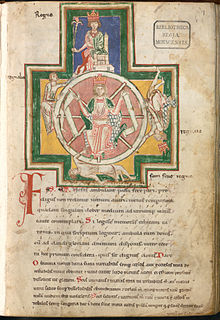Wheel of Fortune (tarot card)

Wheel of Fortune is one of 78 cards in a tarot deck and is the tenth trump or Major Arcana card in most tarot decks. It is used in game playing as well as in divination.
Description

The card pictured is the Wheel Of Fortune card from the Rider–Waite tarot deck. A.E. Waite was a key figure in the development of the tarot in line with the Hermetic magical-religious system which was also being developed at the time,[1] and this deck, as well as being in common use today, also forms the basis for a number of other modern tarot decks.[2]
According to Waite's 1910 book Pictorial Key to the Tarot, the Wheel of Fortune card carries several divinatory associations:
10.WHEEL OF FORTUNE—Destiny, fortune, success, elevation, luck, felicity. Reversed: Increase, abundance, superfluity.[3]
The Wheel Of Fortune card, like other cards of the Major Arcana, varies widely in depiction between tarot decks. The card has been modeled ever since the tarot's inception in the 15th century after the medieval concept of Rota Fortunae, the wheel of the goddess Fortuna. Images generally show a six- or eight-spoked wheel, often attended or crested by an individual (sometimes human; sometimes a Sphinx-like half-human) attired in an Egyptian-style headdress. In some decks, such as the AG Müller, the wheel is also attended by an individual wearing a blindfold; and often there are people sitting or riding on the wheel whilst others are shown falling from it.
The wheel is not always shown inscribed with any lettering. Where this is the case, the letters T-A-R-O (clockwise) or T-O-R-A (counter clockwise) can often be found aligned against four of the spokes, which can also be interpreted as R-O-T-A, the Latin word meaning "wheel". In some decks, such as the Waite, the wheel is also inscribed with additional alchemical symbols representing the four elements: Earth, Air, Fire and Water (which are also said to be represented throughout the tarot by the four "suits" of Pentacles or Discs, Swords, Wands, and Cups respectively.[3] These emblems can also be seen on the Magician's table in the Magician card [Card I]).
On the Waite card shown, though not necessarily on others, there are also four yellow winged creatures in the corners of the card, representing the symbols of the four Evangelists (The Lion, the Ox, the Man and the Eagle). These four Evangelists are also represented by the four fixed astrological signs: Taurus, Leo, Scorpio and Aquarius. In addition a representation of the god Anubis is seen rising with the wheel on the right side, while the snake-like Typhon descends on the left. On the wheel, alternating with the letters T-A-R-O are the Hebrew letters י-ה-ו-ה, usually transliterated as YHWH (Yahweh - Hebrew for God).
Interpretation
A common aspect to most interpretations of this card within a reading is to introduce an element of change in the querent's life, such change being in station, position or fortune: such as the rich becoming poor, or the poor becoming rich.[4]
References
Citations
- ^ Drury (2000).
- ^ Douglas (1972).
- ^ a b Waite (1979).
- ^ Douglas (1972); Reed (1989).
Works cited
- Douglas, Alfred (1972). The Tarot. Harmondsworth: Gollancz. ISBN 9780140037371.
- Drury, Neville (2000). The History of Magic in the Modern Age. Constable. ISBN 9780786707829.
- Reed, Ellen Cannon (1989). The Witches Tarot. Llewellyn. ISBN 9780875426686.
- Waite, A. E. (1979) [1910]. The Pictorial Key to the Tarot. New York: Samuel Weiser. ISBN 0-87728-218-8.
Further reading
- Banzhaf, Hajo (2000). Tarot and the Journey of the Hero. Weiser Books. ISBN 978-1-57863-117-9.
- Butler, Bill (1975). Dictionary of the Tarot. New York: Schocken Books. ISBN 0-8052-0559-4.
- Crowley, Aleister (1991) [1944]. The Book of Thoth: A Short Essay on the Tarot of the Egyptians. San Francisco, CA/Newburyport, MA: Weiser Books. ISBN 978-0-87728-268-6.
- Gray, Eden (1988) [1960]. The Tarot Revealed: A Modern Guide to Reading the Tarot Cards. Signet. ISBN 978-0-451-15673-0.
- Jodorowsky, Alejandro; Costa, Marianne (2009). The Way of Tarot: The Spiritual Teacher in the Cards. Inner Traditions/Bear. ISBN 978-1-59477-656-4.
- Knight, Gareth (1991). The Magical World of the Tarot: Fourfold Mirror of the Universe. Aquarian. ISBN 978-0-85030-940-9.
- Place, Robert (2005). The Tarot: History, Symbolism, and Divination. New York: Penguin Publishing Group. ISBN 978-1-4406-4975-2.
- Pollack, Rachel (1997) [1980]. Seventy Eight Degrees of Wisdom: A Book of Tarot. Thorsons. ISBN 978-0-7225-3572-1.
- Sharman-Burke, Juliet (1985). The Complete Book of Tarot. London: Pan. ISBN 978-0-330-28974-0. OCLC 1029289960.
- Waite, Arthur Edward (February 1926). "The Great Symbols of the Tarot". The Occult Review. 43 (2): 85–86.
- Wood, Juliette (1998). "The Celtic Tarot and the Secret Tradition: A Study in Modern Legend Making". Folklore. 109 (1–2): 15–24. doi:10.1080/0015587X.1998.9715957.
External links
 Media related to Wheel of Fortune (Major Arcana) at Wikimedia Commons
Media related to Wheel of Fortune (Major Arcana) at Wikimedia Commons- X: The Wheel of Fortune - Tarot Card
- v
- t
- e
numbered cards
- O The Fool
- I The Magician
- II The High Priestess
- III The Empress
- IV The Emperor
- V The Hierophant
- VI The Lovers
- VII The Chariot
- VIII (XI) Justice
- IX The Hermit
- X Wheel of Fortune
- XI (VIII) Strength
- XII The Hanged Man
- XIII Death
- XIV Temperance
- XV The Devil
- XVI The Tower
- XVII The Star
- XVIII The Moon
- XIX The Sun
- XX Judgement
- XXI The World
suit cards
| Coins, disks, or pentacles | |
|---|---|
| Wands, rods, staffs, or staves | |
| Cups, goblets, or vessels | |
| Swords or blades |
 Tarot category
Tarot category Card games category
Card games category WikiProject Occult
WikiProject Occult Religion portal
Religion portal















